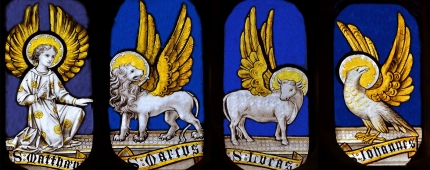Matthew 8:12—Is hell a place of darkness, or is there light there?
Problem: Jesus described hell as a place of “outer darkness” (Matt. 8:12; cf. 22:13 and 25:30). By contrast, the Bible says hell is a place of “fire” (Rev. 20:14) and “unquenchable flames” (Mark 9:48). But, fire and flames give off light. How can hell be utterly dark when there is light there?
Solution: Both “fire” and “darkness” are powerful figures of speech which appropriately describe the unthinkable reality of hell. It is like fire because it is a place of destruction and torment. Yet, it is like outer darkness because people are lost there forever. While hell is a literal place, not every description of it should be taken literally. Some powerful figures of speech are used to portray this literal place. Its horrible reality, wherein body and soul will suffer forever, goes far beyond any mere figure of speech that may be used to describe it. But, it is a serious mistake to take a figure of speech literally. By doing so, one can conclude that God has feathers, since He is described as having wings (Ps. 91:4)! There are other figures of speech used to describe the eternal destiny of the lost that, if taken literally, contradict each other. For example, hell is depicted as an eternal garbage dump (Mark 9:43–48), which has a bottom. But, it is also portrayed as a bottomless pit (Rev. 20:3). Each is a vivid depiction of a place of everlasting punishment.
Matthew 8:20 (cf. Matt. 20:18; 24:30; etc.)—If Jesus was the Son of God, why did He call Himself the Son of Man?
Problem: Jesus referred to Himself most often as the Son of Man. This seems to point to His humanity more than His deity. If He was really the Messiah, the Son of God, why did He use the self-description, “Son of Man”?
Solution: First of all, even if the phrase “Son of Man” is a reference to Jesus’ humanity, it is not a denial of His deity. By becoming man, Jesus did not cease being God. The Incarnation of Christ did not involve the subtraction of deity, but the addition of humanity. Jesus clearly claimed to be God on many occasions (Matt. 16:16–17; John 8:58; 10:30). But, in addition to being divine, He was also human. He had two natures conjoined in one person.
Furthermore, Jesus was not denying His deity by referring to Himself as the Son of Man. The term “Son of Man” is used to describe Christ’s deity as well. The Bible says that only God can forgive sins (Isa. 43:25; Mark 2:7). But, as the “Son of Man,” Jesus had the power to forgive sins (Mark 2:10). Likewise, Christ will return to earth as the “Son of Man” in clouds of glory to reign on earth (Matt. 26:63–64). In this passage, Jesus is citing Daniel 7:13 where the Messiah is described as the “Ancient of Days,” a phrase used to indicate His deity (cf. Dan. 7:9).
Further, when Jesus was asked by the high priest whether He was the “Son of God” (Matt. 26:63), He responded affirmatively, declaring that He was the “Son of Man” who would come in power and great glory (v. 64). This indicated that Jesus Himself used the phrase “Son of Man” to indicate His deity as the Son of God.
Finally, the phrase “Son of Man” emphasizes who Jesus is in relation to His Incarnation and His work of salvation. In the OT (see Lev. 25:25–26, 48–49; Ruth 2:20), the kinsman redeemer was a close relative of someone who was in need of redemption. So Jesus, as our Kinsman Redeemer, was identifying Himself with humankind as its Savior and Redeemer. Those who knew the OT truth about Messiah being the Son of Man understood Jesus’ implicit claims to deity. Those who did not, would not so recognize this. Jesus often said things in this way so as to test His audience and separate believers from unbelievers (cf. Matt. 13:10–17).
See All Problems
This excerpt is from When Critics Ask: A Popular Handbook on Bible Difficulties (Wheaton, Ill.: Victor Books, 1992). © 2014 Norman Geisler and Thomas Howe. All rights reserved. Used by permission. Click here to purchase this book.














